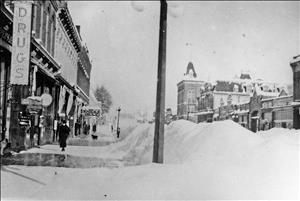In 1880, Dr. Marcel M. Pietrzyski (Pit rus kee) (1843-1910) settles in Dayton, the county seat of Columbia County. A Polish immigrant, Pietrzyski will become an important and influential physician and philanthropist who will be credited with curbing the deadly smallpox epidemic of 1881. Pietrzycki will serve as president of the Eastern Washington Medical Society, as vice president of the Washington State Medical Society, and as mayor of Dayton. The doctor will leave half his estate to Dayton for the establishment of a trade school. The money, along with city taxes, will be used to build Pietrzycki Memorial High School (1923).
Young Man from Poland
Born in Galicia, a Polish province of Austria on April 25, 1843, Pietrzycki immigrated to the United States in 1866 just before the outbreak of the Austro-Prussian War. His father was a district court judge who died in a peasant uprising when his son was 3 years old.
Pietrzycki studied apothecary and chemistry in his native country and immigrated briefly to Pennsylvania before settling in California, where he was appointed as an apothecary at the German Hospital in San Francisco. He attended Toland Medical College and was among the earliest graduates in 1872. Toland later affiliated its school with the medical department of the University of California.
He was a charter member of the Polish Society of California.
Pietrzycki set up his first practice in Stockton, California and later moved to Rio Vista in Solano County, California. He married Mary Stuart Warren (1853-1920), daughter of Reverend J. H. Warren, a prominent pioneer church builder, in June 1876. Pietrzycki was active in the community of Rio Vista while he lived there, serving two terms as a school trustee and working to help establish a telegraph line.
Pietrzycki then moved to Portland, Oregon, and the following year he planned a trip through Oregon and Eastern Washington. He settled in Dayton in 1880 and started a medical practice.
The Smallpox Epidemic
The following year Pietrzycki diagnosed a patient with smallpox, which other physicians had diagnosed as chickenpox. He warned the community that they must take immediate measures to prevent the spread of the disease.
“The Doctor had seen a great deal of this disease and well knew its fearful ravages, and in vain he warned the people of the danger in which they stood. He advised, and even pleaded with them, to take proper measures to prevent the spread of the disease, but to little effect, as they still believed it was nothing but chicken pox” (Gilbert, Historical Sketches ..., 406).
The Dayton sheriff John Mustard appointed Pietrzycki the city’s first health officer the following day, but it wasn’t until two weeks had passed -- and other doctors confirmed more cases of smallpox -- that others heeded Pietrzycki’s warnings.
On November 17, 1881, the board of health, under Pietrzycki’s guidance, issued an order to quarantine the town. The town was quarantined for 10 days in November and the measures worked to stall the spread of the disease.
In its final report to the city council in January, 1882, the Dayton Board of Health reported 100 cases of smallpox and 11 deaths. As a whole Columbia County suffered a total of 167 cases and 21 deaths.
Life in Dayton
Pietrzycki and his wife suffered losses of their own during those years. Their son Warren, born in 1880, died in 1882. Their older daughter Helena, born in 1878, died a year later. The couple had no other children.
Pietrzycki later served as the president of the Eastern Washington Medical Society, and as vice-president of the Washington State Medical Society. By the late 1890s he was serving as mayor of Dayton.
He is perhaps best known for his philanthropic efforts late in life. He owned an estate between Dayton and nearby Starbuck he called Lubla Ranch, which included some 5,500 acres.
The loss of their own children motivated the Pietrzyckis to try to help others. They twice tried to turn the ranch into a collective farming cooperative and hoped to bring people from Austria to settle there. However, failing health and other problems led the Pietrzyckis to change their plans.
“Dr. and Mrs Pietrzycki ... had been bereaved in the loss of their children and felt that their property might well go to the benefactions which would reach the children of the region where their most active years had been spent” (Lyman, Chicago, 326).
Pietrzycki left half of his ranch to the city of Dayton to help establish an industrial department or trade school. Money from the Pietrzycki estate and general bond monies were used to build Pietrzycki Memorial High School, later simply Dayton High School, in 1923. After Mary Pietrzycki died in 1920, the family home in property in Dayton also was given to the schools.
In the spring before his death, Dr. Pietrzycki donated 30 acres of land to the City of Dayton for a park. He died on September 13, 1910, while overseeing site work at the future park.

